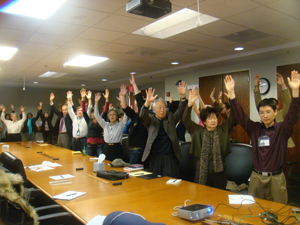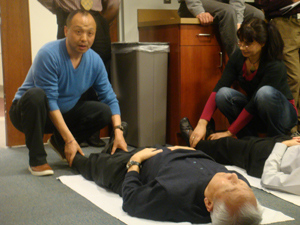Meetings and Events
Spring 2013
Vol. 8, Issue 1
Winter 2013
Vol. 7, Issue 2
Spring 2012
Vol. 7, Issue 1
Spring 2011
Vol. 6, Issue 1
Fall 2011
Vol. 6, Issue 2
Spring 2010
Vol. 5, Issue 1
Fall 2010
Vol. 5, Issue 2
Spring 2009
Vol. 4, Issue 1
Fall 2009
Vol. 4, Issue 2
Spring 2008
Vol. 3, Issue 1
Fall 2008
Vol. 3, Issue 2
Fall 2007
Vol. 2, Issue 2
Winter 2007
Vol. 2, Issue 1
Summer 2006
Vol. 1, Issue 2
Meetings
Meditating on Potential Use of Taiji (T’ai Chi) and Qigong to Reduce Cancer-Related Symptoms

With the pressures of deadlines, projects, and meetings, de-stressing during the workday is often hard for many people to do. However, on April 30th, 2012, more than seventy researchers, clinicians, and members of the general public were one step closer to reducing their stress thanks in part to Yang Yang, Ph.D. Dr. Yang presented a lecture titled “Taiji and Qigong: A Multidimensional Approach to Wellness” during which audience members participated in meditation activities, learned basic taiji movements (also known as t’ai chi), and even danced together. The lecture was hosted by the National Cancer Institute’s Office of Cancer Complementary and Alternative Medicine (OCCAM). Dr Yang’s lecture provided an overview of the traditional practices of taiji and qigong, showcased his prior research, and explored potential avenues for use of taiji and qigong among cancer patients, survivors, and caregivers. “We invited Dr. Yang to visit for two reasons: first, he is interested in doing research with cancer patients and wanted to learn about NCI’s relevant programs and second, to give the NCI staff who manage research portfolios with taiji projects an opportunity to learn more about this practice,” said Dr. Jeffrey D. White, OCCAM’s Director.
A common misconception of taiji is that it is a practice of only slow and choreographed movements. Traditional taiji is more than just slow, deliberate movements; it is composed of static qigong meditations, dynamic movements, and “push hands,” a technique involving a partner that improves balance, reaction time, and strength. Taiji, a form of Chinese martial arts, is rooted in Daoist philosophy, which strives to balance the complementary forces of the yin with the yang. Dr. Yang, a world renowned Taiji and Qigong Master with over 25 years of teaching experience, explained an important component of taiji is the concept of qigong. Qigong describes the interaction of the energy, qi, with the practice or foundation, gong. It is through this interaction that the mental, spiritual, and physical benefits of practicing taiji are obtained.
Traditional taiji practice emphasizes a sequence of static qigong meditations before dynamic, mindful movements are practiced. The sequences of qigong meditations occur while sitting, lying, and standing, although the order does not matter. During his lecture, Dr. Yang described the spiritual and mental benefits of seated meditations as well as the physical benefits, such as increased core strength, before encouraging members of the audience to join him in a seated meditation. He then described the physical benefits of standing meditation, such as improved posture, balance, strength, and sleep. Using a slow cadence, Dr. Yang led the audience through a series of standing meditations and breathing exercises. Finally, with the help of four volunteers, Dr. Yang explained how lying meditations could be used to help combat insomnia, pain, and increase range of motion.
Regardless of the type of meditation practiced, Dr. Yang stressed the ultimate goal of the static qigong meditation is to obtain tranquility within one’s daily life. He also highlighted several other benefits of practicing taiji and qigong including increasing the quality of one’s life, increasing muscle strength, gaining a positive outlook, increasing confidence, and improving one’s sleep.
As both a practitioner and researcher, Dr. Yang is dedicated to using evidencebased research in the use of taiji and qigong as complementary therapies. Dr. Yang earned his Ph.D. in Kinesiology from the University of Illinois, Urbana- Champaign and has used his doctorate to enhance his mastery of taiji practice and to better understand the mechanisms of taiji practice from a biomedical perspective. Dr. Yang is the author of the highly acclaimed book, Taijiquan: The Art of Nurturing, The Science of Power, and has published several biomedical articles. To date, Dr. Yang’s research has focused on the use of taiji and qigong among older adults. More specifically, he has conducted several longitudinal controlled trials to investigate how taiji and qigong improve balance, gait, force control, and lower body strength among older adults and how the use of taiji and qigong influence antibody response to the influenza vaccine.

As the founder and director of the Center for Taiji and Qigong Studies and part-time teacher at Memorial Sloan Kettering Cancer Center, Dr. Yang’s current research interest involves the use of taiji and qigong among cancer patients, survivors, and caregivers. Due to the holistic, mind-body nature of the practice of taiji, Dr. Yang hopes to investigate the role it may play in reducing cancer-related symptoms such as stress, anxiety, insomnia, pain, and fatigue. According to Dr. Yang, “Taiji/qigong combines the benefits of physical exercise and meditation, and I believe there is great potential for this mind/body/spirit integrative exercise to help cancer patients, survivors, and caregivers. Past research has provided a solid framework, but there is much work to be done. To improve trial design and continue to build a solid body of evidence, researchers should recognize that the basic model of therapeutic benefit from mind/body/ spirit integrative exercise is systemic, and therefore quite different from cellular pathology which is the foundational paradigm of pharmaceutical research. The dosage of taiji/qigong therapy delivered to subjects, though central to clinical research, is largely unknown, yet certainly variable, both between and within existing studies. The dosage of any mind/body therapy is a function of both quantity and quality of practice. Though a challenging task, we need to develop methods to characterize and measure dosage in future taiji/qigong trials.”
OCCAM Fellow Presented Research at the Latino Medical Student Association Conference
In February 2012, OCCAM Cancer Research Training Award (CRTA) Fellow Jeans Santana presented a poster at the Latino Medical Student Association (LMSA) Joint 7th Annual National and 39th Annual Northeast Conference at Harvard Medical School in Boston, Massachusetts.
The LMSA was founded in 1987 as the National Network of Latin American Medical Students to help support, educate, and unify Latino(a) medical students in the United States. The network is composed of members from five regions across the United States: Midwest, Northeast, Southeast, Southwest, and West.
This year’s conference was open to participants at all stages of their medical (and pre-medical) careers — attendees ranged from high school students with a dream of pursuing medicine to physicians seeking to mentor young students.
Mr. Santana presented research that examined the prevalence of complementary and alternative medicine (CAM) use and the effect of acculturation among U.S.- and foreign-born Hispanic adults diagnosed with cancer. The data were obtained from two large surveys: the 2001 California Health Interview Survey and the 2007 National Health Interview Survey. A portion of the data is still being analyzed, but so far, the findings have suggested that CAM use among the patients surveyed was high. The most commonly reported CAM modalities used were physical activity and manipulative and body-based therapies. Mr. Santana concluded that future studies should oversample Hispanic cancer patients and investigate health-seeking behavior in the Hispanic population and the safety and efficacy of CAM therapies.
Attending the LMSA Conference was a positive experience for Mr. Santana, who is attending medical school in the fall. “Aside from the opportunity to present my research and represent OCCAM, I was able to attend a number of extremely useful workshops. Through these workshops, I learned about conducting clinical and basic science research after medical school, how to prepare for the United States Medical Licensing Exam Steps 1 and 2, and how to manage finances throughout medical school,” he noted. Mr. Santana was also impressed by the keynote speaker, Dr. Raul Ruiz, who “talked about achieving big in the medical field and also the responsibility we should carry for those voices not commonly heard in public health policy meetings, such as minority and underserved populations.”





